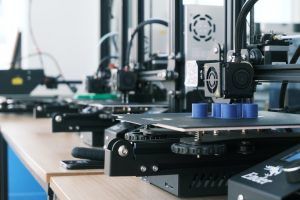
The use of automation in the manufacturing industry isn’t a new concept. Manufacturing plants across the globe have been using machines to optimize the assembly line and skyrocket efficiency. When judiciously used, it can help take the load off of workers’ shoulders and ensure their safety.
But automation technology has come a long way since the term was first coined in the automobile industry by D.S. Harder. Today, manufacturing units have access to sophisticated equipment, such as print and apply labeling systems and 3D printers.
Also, you can now leverage cutting-edge tech innovations, including artificial intelligence (AI) and the Internet of things (IoT). You can even utilize data analytics to improve operations and generate maximum revenue.
If you run or manage a manufacturing plant, it’s necessary to stay on top of the latest trends in automation and understand their impact on the industry. In this blog, we’ll take a closer look at how new-age automation technologies are transforming the manufacturing industry. Let’s get started.
Optimizing Operations & Increasing Efficiency
One of the key reasons manufacturing plants implement automation is to enhance their operational efficiency. The use of sophisticated machines and tools can be instrumental in eliminating routine tasks from your staff’s schedule.
For instance, you can use a print and apply labeler to automate the process of labeling finished products. You can use the machine to add product information, safe handling instructions, certification details, etc. to the product packaging.
It saves your workers from the hassle of manually printing various labels and sticking them on the product. This, in turn, skyrockets the overall speed of the process. Also, it helps eliminate any chances of human errors.
Similarly, you can deploy co-bots to work alongside your employees on the assembly line. While the machines and robots do all the heavy lifting, your employees get more time to focus on further improving the manufacturing process. It enhances their productivity and prevents them from feeling burnt out.
Similarly, you can leverage digital twinning to further improve manufacturing processes. It involves running a virtual model alongside a real-life system to gather data on operational issues. It facilitates data-driven decision-making to improve product quality, employee performance, and overall revenue.
Apart from increasing the final output and revenue of your manufacturing facility, the use of automation also helps you contribute to global economic growth. A recent study has shown that implementing automation at a macroeconomic level will increase the global manufacturing GDP by up to 1.4% every year. That translates to more industrial growth and sales.
Maintaining Business Continuity
Automating key manufacturing processes helps keep your plant running seamlessly in the event of a natural or man-made calamity. For instance, if your workers can’t reach the manufacturing facility due to a natural disaster, you can use AI and predictive analysis to continue key operations.
That’s the reason many manufacturing companies have turned to automation during the COVID-19 pandemic. Crowding your plant with too many employees makes it difficult to maintain social distancing regulations. This, in turn, could jeopardize worker safety and create a bad reputation for your facility.
That’s where co-bots step into the picture. They help run the assembly line without any interrupting while letting workers adhere to social distancing regulations. That means you can run your unit despite reduced manpower, and without compromising the wellbeing of your workers.
Additionally, IoT applications let employees remotely monitor and control various parameters to ensure operational efficiency and eliminate errors. They can schedule routine maintenance and other tasks in advance. They can even set up various alarms to notify them when the need for human intervention arises.
Facilitating Predictive Maintenance
Working with faulty equipment is one of the biggest logistical hiccups for every manufacturing facility. Apart from plummeting efficiency, it could also be a safety hazard for your employees. Wouldn’t it be great if there was a way to preempt the need for maintenance instead of repairing them after a breakdown or accident?
That’s precisely what artificial intelligence helps you achieve. Modern AI technology uses a mix of sensors and data analytics to monitor your systems and predict operational issues before they escalate into full-blown workplace hazards.
What Does the Future Hold?
While automation has been integral to manufacturing for several decades, the pandemic has reinforced its importance. Manufacturing units have leveraged new-age tech innovations to continue their operations despite quarantine and social distancing regulations. Expect to see more applications of automation, including janitorial robots, to bolster workplace safety in the years to come.











